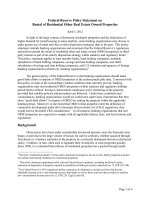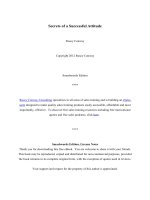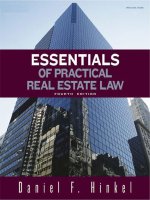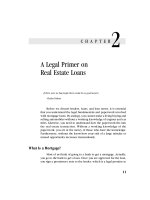HandBook Financing Secrets of a Millionaire Real Estate Investor_5 ppt
Bạn đang xem bản rút gọn của tài liệu. Xem và tải ngay bản đầy đủ của tài liệu tại đây (556.43 KB, 21 trang )
7/ Partnerships and Equity Sharing
95
together for the purchase of properties at a foreclosure auction. This
type of arrangement should be approached with extreme caution
because it looks more like a general partnership than a joint venture.
It also may cross over into securities regulations, particularly if you
are the one soliciting money from other investors.
Legal Issues
Owning real estate jointly with other parties is an effective
financing tool, but it can also be a liability. Under the Uniform Part-
nership Act, the law holds all partners liable for each other’s actions.
Thus, if you are a “silent” partner, you could be held liable as the “deep
pocket.” Consider setting up a limited liability company
(
LLC
)
or lim-
ited partnership for joint venture projects. The owners of an LLC are
shielded from liability for activities of the company and the activities
of each other. Limited partners
(
but not general partners
)
of a limited
partnership are similarly shielded from personal liability.
For more information on LLCs and limited partnerships, visit my
Web site at
<
www.legalwiz.com/LLC
>
.
Alternative Arrangement for Partnership
Rather than having a partnership own the property, partners can
realize the same profit goals by using a note and security instrument.
One partner will hold title to the property and sign a note to the other
partner for the amount of the other partner’s cash investment. The
note is secured by a mortgage on the property. A second note and
mortgage is also executed, which will be a shared equity mortgage. A
shared equity mortgage
has a payoff that is based on a formula that
relates to the increase in value of the property.
Shared equity mortgages
(
AKA shared appreciation mortgages
or participation mortgages
)
were popular when interest rates were so
high that commercial borrowers could not maintain positive cash
96
FINANCING SECRETS OF A MILLIONAIRE REAL ESTATE INVESTOR
flow. The lender thus dropped the interest rate in return for a share
of the future profits in the borrower’s property. Today, shared equity
mortgages are not as popular, but they are still an effective tool for
financing properties with people who are open-minded.
Case Study: Shared Equity Mortgage with Seller
A viable option for seller financing is to make the seller your part-
ner with a shared appreciation mortgage. In this case, the seller/
lender shares in the future appreciation of the property. A seller may
be willing to accept little or nothing down in exchange for principal
and interest payments, lack of management, and future appreciation.
Essentially, the note and mortgage documents read the same as a stan-
dard note and mortgage, except that the payoff amount increases over
time in proportion to the value of the property. The shared apprecia-
tion can be written a number of ways and need not necessarily be a
50/50 split of future appreciation.
Tax Issue for the Lender
Normally, an investor must pay profits when he or
she sells investment property for a gain. An owner
(
or co-owner
)
of real estate can defer paying taxes
on this gain by exchanging under Section 1031 of
the Internal Revenue Code. Because the partner
holding the shared appreciation mortgage is not
an owner of the real estate, he or she is not able to
take advantage of a Section 1031 exchange
(
for
more information on tax-deferred exchanging, go
to
<
www.1031x.com
>
)
.
7/ Partnerships and Equity Sharing
97
When Does a Partnership Not Make Sense?
Real estate partnerships, like any business partnership, should be
approached with profit in mind. Buying property jointly with a friend
makes no sense just because you want to limit your exposure to half
the loss. Likewise buying property with a partner should be avoided
if the partner’s share of the profit is less than you could pay for a loan.
Even at 18 percent interest and with 10 points origination fee, you
might still end up with more profit by borrowing hard money. Use
your common sense and a calculator, not your emotions and fears.
An equity partner should be used when conventional, hard-
money, seller-carryback, and creative financing means are out of the
question. In my experience, if you need a partner to finance the deal,
it may not be all that good a deal; if you buy at the right price, borrow-
ing the necessary money is easy. However, there is one exception to
this rule: If your partner has a great deal more experience than you,
Is a Shared Equity Mortgage a Partnership?
When using shared equity mortgages, there is a
fine line between a lender/borrower and a part-
ner/partner relationship. There could be adverse
tax and legal consequences if a court or the IRS
were to recharacterize a lender/borrower relation-
ship to that of a legal partnership. The key legal
distinction is the sharing of losses by the lender in
the transaction. Because a partnership involves
the agreed sharing of profits and losses, removing
the lender’s risk of loss will help avoid the rechar-
acterization. As with any complicated transaction,
you should hire the services of a competent attor-
ney to draft or review the paperwork.
98
FINANCING SECRETS OF A MILLIONAIRE REAL ESTATE INVESTOR
giving up part of the profit for a good education may be worthwhile.
And, suffice it to say, make sure you know who you are partnering
with by checking out his or her background and references.
Key Points
•
Equity sharing and joint ventures can be effective financing
alternatives.
•
Approach general partnerships with extreme caution.
•
Consider alternatives to partnerships whenever possible.
99
CHAPTER
8
The Lease Option
The road less traveled is that way for a reason.
—Fortune Cookie
The lease-option strategy is a great way to leverage your real es-
tate investments because it requires very little cash. The lease-option
method is more of a financing alternative than a financing strategy be-
cause you don’t own the property.
The basic lease-option strategy involves two legal documents, a
lease agreement and an option. A lease gives you the right to possess
the property, or, as an investor, to have someone else occupy it. If you
can obtain a lease on a property at below market rent, you can profit
by subleasing it at market rent.
An
option
is the right to buy a property. It is a unilateral or one-
way agreement wherein the seller obligates himself or herself to sell
you the property, but you are not obligated to buy it. By obtaining the
right to buy, you control the property. You can market the property
and sell it for a profit. The longer you can control the property in an
appreciating market, the more value you create for yourself. By com-
bining a lease and an option, you create a lease option.
100
FINANCING SECRETS OF A MILLIONAIRE REAL ESTATE INVESTOR
Financing Alternative
The two primary objectives of the real estate investor are cash
flow and appreciation. You don’t need to own a property to create
cash flow or benefit from appreciation. Because a lease entitles you to
possession, it allows you to create cash flow. An option gives you the
right to buy at a set price, allowing you to benefit from future appre-
ciation.
Lease—The Right to Possession
Under a lease agreement, the lessor
(
landlord
)
gives the lessee
(
tenant
)
the right to possess and enjoy the property, one of the most
important benefits of real estate ownership. The lessee is usually not
responsible for property taxes and major repairs. Once you have the
right to obtain possession of property, you can profit by subletting or
assigning your right to possession.
Sublease
A
sublease
is a lease by a tenant to another person, a subtenant,
of a part of the premises held by the tenant under a lease. The sublease
can be for part of the premises or part of the time period. For exam-
ple, if the tenant has a three-year lease agreement with the landlord,
the tenant can sublease the rental unit for two years, or sublease part
of the unit for three years.
Assignment
An
assignment
is a transfer to another of the whole of any prop-
erty or any estate or right therein. As with a sublease, the master tenant
8/The Lease Option
101
is not relieved from liability for obligations under the lease. However,
the assignee of a lease is in contract with the landlord, and thus the
landlord can collect from the assignee
or
the master tenant for nonpay-
ment of rent.
Assignment and subletting are always permissible without an
express provision in the lease forbidding the tenant from doing so. As
a tenant/investor, it is imperative that there are no antiassignment or
antisubletting clauses in your lease with the owner of the property.
More on Options, the “Right” to Buy
A real estate sales contract is a
bilateral,
or two-way, agreement.
The seller agrees to sell, and the purchaser agrees to buy. Compare
this agreement with an option; an option is a
unilateral
contract in
which the seller is obligated to sell, but the purchaser is not obligated
to buy. On the other hand, if the purchaser on a bilateral contract
refuses to buy, he or she can be held liable for damages.
A bilateral contract with contingency is similar to an option.
Many contracts contain contingencies, which, if not met, result in the
termination of the contract. Essentially, a bilateral contract with a con-
tingency in favor of the purchaser turns a bilateral contract into an op-
tion in that it gives the purchaser an “out” if he or she decides not to
purchase the property. Though the two are not legally the same, an op-
tion and a bilateral purchase contract with a contingency yield the
same practical result.
The receiver of the option
(
optionee
)
typically pays the giver of
the option
(
optionor
)
some nonrefundable option consideration, that
is, money or other value for the right to buy. If the option is exercised,
the relationship between the optionor and optionee becomes a bind-
ing, bilateral agreement between seller and buyer. In most cases, the
option consideration is credited towards the purchase price of the
property. If the option is not exercised, the optionee forfeits the op-
tion money.
102
FINANCING SECRETS OF A MILLIONAIRE REAL ESTATE INVESTOR
As seen in the following examples, an option can be used to gain
control of a property without actually owning it:
•
A speculator who is aware of a proposed development can
obtain options on farmland and then sell the options to devel-
opers.
•
To take advantage of appreciation in a hot real estate market,
an investor can use a long-term option to purchase property.
•
To induce timely rental payments, a landlord can offer the ten-
ant an option to purchase.
There are literally hundreds of ways that an option can be struc-
tured, and every detail is open for negotiation between the optionor
(
seller
)
and optionee
(
buyer
)
.
An Option Can Be Sold or Exercised
An option, like a real estate purchase agreement, is a personal
right that is assignable. If you were able to obtain an option to pur-
chase at favorable terms, you could sell your option. The assignee of
the option would then stand in your shoes, having the same right to
exercise the option to purchase the property. As with a lease, an
option is freely assignable absent an express provision in the option
agreement to the contrary.
Alternative to Selling Your Option
Rather than sell your option to purchase, you may wish to exer-
cise the option yourself, then sell the property to a third-party buyer
in a double closing, as described in Chapter 5.
8/The Lease Option
103
The Lease Option
A lease option is really two transactions: a lease and an option to
purchase. Under a lease, a tenant may have the option to buy the prop-
erty. The option itself can be structured in various ways. For example,
the option may be that of a right of first refusal in the event the land-
lord intends to sell the property. The option may also be an exclusive
option for the tenant to buy at a certain price. When combined with
a lease, a purchase option may also include rent credits, that is, an
agreement that part of the monthly rent payments will be applied to
reduce the purchase price of the property. There are literally hun-
dreds of ways that an option or lease option can be structured, and
every detail is open for negotiation between the landlord and tenant.
The Lease Purchase
The lease purchase, like a lease option, is two transactions: a
lease and a purchase agreement. A regular purchase contract is a bind-
Famous Option Story
The most infamous option financing story is how
the United Nations found its way to New York City.
In the mid-1940s, William Zeckendorf, a now infa-
mous developer, took options on multiple water-
front lots on the east side of Manhattan. At the
time, the properties were primarily being used for
slaughterhouses. Zeckendorf’s option price for the
lots was $6.5 million. With the help of the Rock-
efeller family, the United Nations purchased the
property from Zeckendorf for $8.5 million.
104
FINANCING SECRETS OF A MILLIONAIRE REAL ESTATE INVESTOR
ing bilateral agreement; the seller agrees to sell and the buyer agrees
to buy. An option binds the seller to sell, but the buyer is not bound
to buy. If the buyer on a bilateral contract fails to buy, he or she is in
breach of contract. However, a properly drafted agreement will limit
the seller’s legal remedy to simply keeping the buyer’s earnest money
(
called a “liquidated damages clause”
)
. Thus, as a practical matter, the
result is the same as if the buyer gave nonrefundable option money
and failed to exercise his or her option.
In practice, lease purchase and lease option are just buzzwords
that mean the same thing. Except as noted, we will use the two terms
throughout this book interchangeably.
Lease Option of Your Personal Residence
Pride of ownership is what makes so many Americans obsessed
with the idea of owning a home. Once you get over this idea, you will
see that you can often rent more home than you can buy.
Why buy when you can rent?
We’ve all seen the ads used by real
estate agents: “Why rent when you can buy?” Consider the other side
of the coin: “Why buy when you can rent?” In most parts of the coun-
try, a typical $100,000 house will rent for about $1,000 per month. As-
suming a reasonable down payment and interest rate, the monthly
mortgage payments would be less than $1,000 per month. In this case,
it makes sense to own the home. However, more expensive homes
don’t rent as well as cheaper homes. A typical $500,000 home does not
rent for $5,000 per month. The more expensive the home, the cheaper
it becomes to rent compared to buy. If you are concerned about the
proverbial “throwing away rent,” consider a lease option of your next
home.
Case study: lease option builds equity.
A student of mine from
the Phoenix area
(
we’ll call her Sharon
)
was interested in purchasing
a home to live in, but she didn’t have much cash. She was at her new
8/The Lease Option
105
job just a short time and could not qualify for a conventional or an FHA
low-down-payment loan. Sharon found a seller with a nice property,
with little equity but with a low-interest-rate loan. Sharon leased the
property from the owner for three years for $1,200 per month, with
an option to buy at $162,000. The agreement provided that the seller
give her a 25 percent
(
$300
)
credit towards the purchase price for
each rent payment made. Sharon put up just $500 as a security deposit
that would be credited toward the purchase price when she exercised
her option to purchase.
After 18 months, the property had appreciated $17,000 in value
to $179,000. In addition, Sharon’s “equity” had increased $5,400 be-
cause of the $300 per month rent credit. Thus, Sharon’s equity posi-
tion was almost $23,000:
Sharon exercised her option to purchase the property and sold it
to a third party, pocketing the cash difference.
A few points are worth noting here: First, had Sharon purchased
the home 18 months earlier, she would have been required by the
lender to put up several thousand dollars for a down payment and loan
costs. Because Sharon intended to live in the property for just a few
years, she maximized her profit by using a lease option to control the
property for 18 months, rather than a mortgage loan.
Second, Sharon’s risk is limited to her $500 investment. If Sharon
had bought the property with conventional financing and property
values had declined over the 18-month period, Sharon would have
been stuck with the property. As you can see, using options to lever-
$162,000 Option price
–5,400Rent credit
– 5,500 Security deposit
$156,100 “Strike price”
$179,000 Market value
–156,100 Strike price
$ 22,900 “Equity”
106
FINANCING SECRETS OF A MILLIONAIRE REAL ESTATE INVESTOR
age real estate is an effective alternative to bank financing when
future real estate values are uncertain.
The Sandwich Lease Option
The sandwich lease option is an old technique used by real estate
entrepreneurs to create cash, cash flow, and equity buildup with lit-
erally no money, credit, or bank loans.
Let me give you a typical example of how a sandwich lease
option works. A seller
(
soon to be
landlord
)
is transferred out of town
and rents his property. A year later, the tenant vacates
(
after skipping
a few months rent
)
and leaves a big mess. The owner wants to sell the
property for $110,000. It is the middle of the winter, the house is
vacant, and the real estate market is a bit slow.
Lease Option REFI
Rather than sell the property, Sharon in our Case
Study could have obtained a loan to buy the prop-
erty. In doing so, most lenders would consider the
transaction a purchase and lend basing their LTV
on the option strike price
(
$156,100
)
, not the ap-
praised value
(
$179,000
)
. A small number of lend-
ers will treat the transaction as a refinance
(
REFI
)
,
in which case the LTV is based on the appraised
value. So, a 90 percent LTV refinance would allow
a lender to give Sharon .9 × $179,000 = $161,000,
which would cover the strike price and the loan
costs. Because a lease option REFI is not an ordi-
nary transaction, be patient if you are looking for
a lender that will fund in this manner; it will take
a lot of phone calls!
8/The Lease Option
107
The house needs new paint and carpet and therefore looks ugly.
The $850 per month mortgage payment is a burden to the owner. He
decides to lease it on a month-to-month basis but cannot find a tenant
because nobody wants to lease a house for sale when he or she may
have to leave within a few months. The owner is a perfect candidate
for a lease option.
The potential buyer
(
AKA tenant
)
filed for bankruptcy two years
ago. He just moved to town. A lthough he has stable income, he cannot
yet qualify for a loan. In addition, he still has to sell his old house to
raise some cash for the down payment. He doesn’t really want a
straight rental, yet he is not ready to buy today. The tenant is a perfect
candidate for the other end of a lease option. See Figure 8.1.
Cash Flow
So how do we, as real estate investors, fit in? Find the owner who
fits the picture and sign up a lease-option agreement wherein you are
the tenant/buyer. You are not going to live in the property but are still
considered a “master tenant.” The lease-option agreement will give
you the right to sublet the property. If the price you pay is lower than
market rent, you can create cash flow by subletting the property to
another tenant. Depending on the deal, this can create several hun-
dred dollars per month of cash flow—not bad for a property you don’t
even own!
Equity Buildup
After a year or two, you may have accumulated some equity in
one of the following ways:
•
Appreciation of the property due to inflation
•
Increase in value from improvements on the property
108
FINANCING SECRETS OF A MILLIONAIRE REAL ESTATE INVESTOR
•
Increase in equity from rent credits offered by the landlord/
seller
Once your
equity,
the difference between the market value and
your option strike price, reaches around 10 percent, you can obtain
lender financing and buy the property. Or, you can offer the property
for sale to another investor. Better yet, offer the property for sale to the
tenant. In many cases, a tenant/buyer is willing to pay more than the
property is worth! When the tenant is ready to exercise his option, you
exercise your option from the owner and sell it to the tenant in a back-
to-back double closing for a profit.
Straight Option without the Lease
A purchase option can be used without a lease to gain control of
a property and create a profit. Once you have obtained an option, you
can either sell
(
assign
)
your option for immediate profit or exercise
FIGURE 8.1
Sandwich Lease Option
Landlord/Seller
Master Tenant/Buyer
Subtenant Buyer
8/The Lease Option
109
your option to purchase and simultaneously sell it to a third-party
buyer. If you are speculating that a particular area is ripe for develop-
ment, you can use an option as a long-term investment technique.
An option is a leveraged, low-risk investment; you can obtain an
option with 1 percent or less of the purchase price in cash. Again,
using options in lieu of conventional financing is cheaper and less
risky when you are dealing with a real estate market that has an uncer-
tain future.
Case Study: Sandwich Lease Option
I was referred to a woman who had a house she needed to sell in
a hurry because she had a job transfer. She had tried to sell the prop-
erty with a real estate agent, but, at the last minute, the buyer could
not qualify for a new loan.
The house was a small two-bedroom ranch that was worth ap-
proximately $45,000. The balance of the existing loan was approxi-
mately $38,000, with monthly payments of $380 per month
(
including
taxes and insurance escrows
)
. Although the average rents in the neigh-
borhood were about $575, she was not interested in becoming a long-
distance landlord.
I offered to lease the property for $380 per month, with an option
to purchase at $38,000
(
the balance owed on her mortgage loan
)
. I had
the right to sublet, but I explained to her that my payments to her were
not contingent on occupancy. This alleviated her fear of having to deal
with the property if it became vacant.
I subletted the property for market rent, which was $575. After
about two years, the market value of the property had risen to $75,000,
so I exercised my option to buy at $38,000. Based on a $75,000
appraisal, I had no problem obtaining solid, institutional financing for
the property. In fact, I even pulled out $4,000 from the refinance to
make capital improvements to the property. My payments went up,
but so did the rents, based on the improvements and increase in value
of the neighborhood.
110
FINANCING SECRETS OF A MILLIONAIRE REAL ESTATE INVESTOR
For more information on using lease options, take a look at my
home study package, “Big Profits with Lease options,” at
<
www.legal
wiz.com
>
.
Sale-Leaseback
The sale-leaseback is a financing technique that has been used in
the United States since the 1940s. The transaction, in its most basic
form, involves the sale of a property to an investor who holds title and
leases the property back to the former owner. The lease is typically a
long-term net lease with the seller/tenant having the option of repur-
chasing at a later time. The seller/tenant reaps the benefit of favorable
100 percent “financing” and still retains the use of the property.
The buyer/landlord receives the tax benefit of depreciation and
a guaranteed long-term rental. To do this with nothing down, simply
sign a contract to purchase the property from the seller, then another
contract to sell it to an investor. In a double closing, you purchase the
property from the seller and resell it to the investor, who then leases
it back to you, giving you an option to repurchase. You can then rent
it out for cash flow or sublease it with an option to a tenant/buyer as
described previously in this chapter.
The sale-leaseback has its drawbacks. If either party to a sale-
leaseback is audited, the IRS may recharacterize the sale-leaseback as
a disguised financing arrangement. This will result in an immediate
recapture of the buyer/landlord’s depreciation of the property and
imputed interest on the seller/tenant’s rental payments. The seller/
tenant will lose the deduction for his or her rental payments because
the payments will be reclassified as principal repayment of a loan.
The United States Supreme Court, in the landmark case of
Frank
Lyon Co.
v.
United States,
stated the factors to be considered for re-
characterization are
•
the economic substance of the transaction based upon the
potential risks and gains of the parties, and
8/The Lease Option
111
•
whether there was a purpose other than tax avoidance for the
transaction.
While the above standards set forth by the court are not crystal
clear, following are a few guidelines that we can follow to avoid
recharacterization:
•
Make certain that the purchase price of the property is for fair
market value.
•
Make certain the lease payments are for fair market rent, and
that the lease arrangement is typical of the area and the in-
tended use.
•
Have reasons
(
other than tax avoidance
)
for the transaction and
state those reasons in the preamble of your agreement.
•
If the seller/tenant has an option to repurchase, make certain
that it is based upon fair market value and not on a declining
basis with unusually large rent credits
(
i.e., make sure it doesn’t
look like a loan payoff
)
.
•
Make certain that the buyer/landlord has the rights of any typ-
ical landlord in a comparable lease arrangement
(
including the
right to have the property back at the end of the lease!
)
.
Make certain that there is nothing in the sale-leaseback arrange-
ment that prevents the buyer/landlord from selling, mortgaging, or
assigning his or her interest or benefiting from future appreciation of
the property.
Case Study: Sale-Leaseback
A client of mine
(
we’ll call him Chris
)
used a sale-leaseback to
profit in a win/win arrangement with a builder. The builder had
finished developing the first phase of a new housing project. The
builder’s lender wanted to make sure a majority of the houses from
112
FINANCING SECRETS OF A MILLIONAIRE REAL ESTATE INVESTOR
the first phase were complete before extending the builder more
credit to build the second phase.
Chris offered to purchase the model homes the builder used to
show to prospective purchasers. Chris and the builder entered into a
sale-leaseback agreement, wherein Chris bought the properties at 80
percent of fair market value, then leased the properties back to the
builder to use as model homes. Because the builder was able to show
his lender that three of the homes in the first phase of the subdivision
were sold, the builder was allowed to borrow more money for the
next phase of the development. By the time the third phase of the
development was complete, the builder no longer needed the model
homes. The property values had increased, and Chris sold the homes
for a substantial profit.
Key Points
•
The lease option is an excellent, high-leverage financing alter-
native.
•
The sandwich lease option is a cash flow generator.
•
The sale-leaseback is another excellent financing alternative.
113
CHAPTER
9
Owner Financing
If you’d like to know the value of money, go and try to borrow some.
—Benjamin Franklin
Owner financing is one of the best sources of capital for your real
estate purchases. In an ideal world, every real estate purchase you
made would be with owner financing. Low risk, an endless supply of
funding, and great terms—what more could you ask for?
First, let’s start with a definition of owner financing. An
owner-
financed transaction
is one in which the seller accepts anything less
than all cash at the closing. Let’s step back and define an all-cash clos-
ing. An
all-cash closing
does not necessarily mean the buyer walks
into closing with a briefcase full of money; all cash means the seller
gets all cash
(
actually, the seller may use most of the cash to pay off the
existing mortgage loan, so he or she walks away with some cash
)
. If the
seller accepts any part of the purchase price in the form of payments
after the closing date, then it is an owner-carry sale. An
owner-carry
sale
may involve the seller financing, or “carrying,” the entire pur-
chase price.
114
FINANCING SECRETS OF A MILLIONAIRE REAL ESTATE INVESTOR
Example:
Sally Seller owns her home free and clear, that is,
she owes nothing to the bank and there are no mortgage
liens on the property. Sally agrees to sell her property to
Barney Buyer for $100,000; the terms are 5% down and
owner-financing for $95,000, or 95%, of the purchase price.
At closing, Barney tenders $5,000 in cash and signs a note
for $95,000. Sally executes and delivers a deed to Barney.
The note is secured by a mortgage or deed of trust that is re-
corded against the property as a lien in favor of Sally.
The preceding example is a rare case because most sellers owe
some money to a lender. In addition, most sellers want the maximum
amount of cash from the sale and are not necessarily willing to accept
as little as 5 percent down. As such, the seller may be willing to accept
a partial owner-carry sale.
Example:
Sammy Seller owns a property worth $100,000
that is encumbered by a mortgage of $70,000. Sammy agrees
to sell the property to Betty Buyer for $100,000. Because
there is $30,000 in equity
(
$100,000 value minus $70,000
loan
)
, Betty offers to pay $10,000 down and $20,000 in
monthly installments with interest. The balance of the
$70,000 due under the purchase price is borrowed from a
third-party lender. At closing, Betty borrows $70,000 from
the third-party lender, which is tendered to Sammy, who
uses the cash to pay off his existing mortgage loan. Betty ex-
ecutes a mortgage or deed of trust to the third party lender,
who has a new first lien position on the property.
Betty tenders $10,000 in cash and a note for $20,000 to Sammy.
Betty also executes a mortgage or deed of trust to Sammy, who has a
second lien position on the property. See Figure 9.1.
☛
☛
9 / Owner Financing
115
Advantages of Owner Financing
As discussed next, there are many advantages of owner financing
over conventional financing for the buyer/investor.
Easy Qualification
Owner financing is more attractive than conventional financing
because it does not require traditional lender income and credit
approval. If you have poor credit or lack of provable income, the tra-
ditional route of institutional financing may not work. Few conven-
tional lenders offer low, fixed-interest-rate loans to people with a
poor credit rating. In addition, lenders may be leery about extending
too much credit to you if you own a lot of properties. And, when you
FIGURE 9.1
Owner-Carry Financing Example
Sammy Seller
$70,000
1st Mortgage
$20,000
2nd Mortgage
Deed
Betty Buyer Lender
Cash









